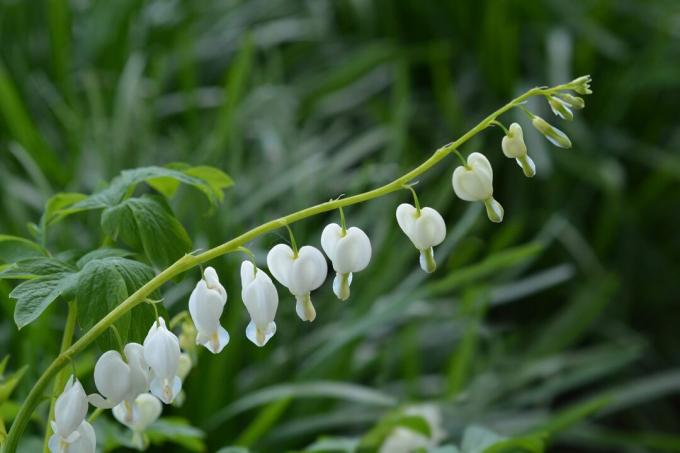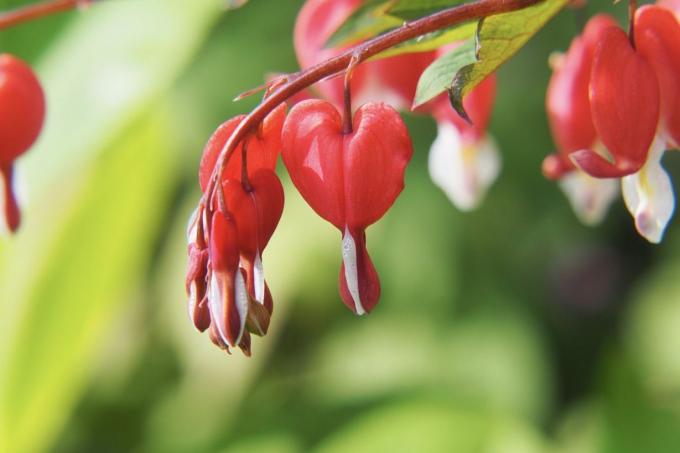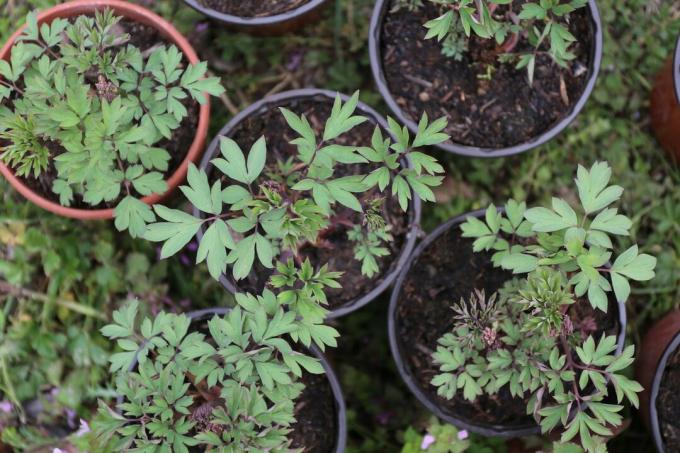As sad as its name sounds, the Bleeding Heart flower gives every garden that certain something with its unusual blossoms. We present the most beautiful varieties, show you how to properly plant and care for the bleeding heart, and reveal whether the plant is poisonous.

The Bleeding Heart (Lamprocapnos spectabilis) is not only a classic in cottage gardens. As a perennial spring perennial, it impresses above all with its spectacular and filigree flowers.
"Contents"
- Bleeding heart: flowering time, characteristics and origin
-
The most beautiful varieties of the flower bleeding heart
- Bleeding heart: white varieties
- Bleeding heart: red varieties
- Bleeding heart: black and blue varieties
- Bleeding heart: yellow varieties
- Is the bleeding heart hardy?
-
Plant a bleeding heart
- The perfect location for the bleeding heart
- This is how you plant bleeding hearts
- Care for bleeding hearts: everything for watering, fertilizing and cutting
- Is the Bleeding Heart Poisonous?
Bleeding heart: flowering time, characteristics and origin
The bleeding heart belongs to the poppy family as well as the subfamily of the fume family (Fumariaceae) and is often still under the old name in the plant trade Dicentra spectabilis offered. The plant originally comes from China and Korea, where it can be found in light, moist deciduous forests. The graceful perennial came to Northern Europe less than 200 years ago. It has always fascinated gardens and parks with its special flower shape, to which it owes its dramatic name.
The perennial, bushy perennial reaches a height of up to 80 cm and forms arching, hanging shoots. During the flowering period from April to June, these bear eight to twelve heart-shaped individual flowers with a teardrop-shaped extension that looks like a falling teardrop. In the natural variant, the flowers are pink-white in color. The tender leaves of the Bleeding Hearts are strongly pinnate, lobed and appear a fresh green. The foliage dies after flowering and the nutrients and reserves are drawn into the root ball.

There is also a Japanese legend about the characteristic flower shape: a young man tried to win a girl's heart by giving her two rabbits, a pair of shoes and earrings gave. When she refused his gifts and thus his love, however, he stabbed his heart with a dagger, so that in his grief it turned into a tearful heart.
Is the bleeding heart friendly to bees? The perennial attracts a variety of insects, but due to the elongated shape of the flower, it is primarily long-nosed insects that manage to get to the bottom of the narrow flower. Bumblebees use their mouthparts and bite a hole in the flower to get the nectar. The resulting entrances are then also used by bees and other insects.
The most beautiful varieties of the flower bleeding heart
There are many different varieties of Lamprocapnos spectabilis respectively Dicentra spectabiliswhich differ primarily in the color of the flowers. In addition to the classic variety with the pink and white flowers, there are also white, red and yellow flowering varieties. In addition, the varieties also differ in their height and leaf color. For example, the foliage of the 'Goldheart' variety glows green-yellow and the foliage of the 'Stuart Boothman' variety has a bluish tinge.
Bleeding heart: white varieties
- 'Alba': pure white flowers; Foliage appears in fresh green; with a stature height of 50 - 70 cm slightly smaller than the original species; Flowering period: May to June.
- 'White Gold': white flowers; green-yellowish foliage; Height: 60 - 90 cm; Because of the white flowers and the light foliage, it stands out especially in dark areas of the garden.

Bleeding heart: red varieties
- 'Valentine': cherry-red and white flowers; dark green, reddish shimmering leaves; Height: 70 - 80 cm; Flowering period: May to June.
Other Dicentra-Species resemble the bleeding heart in their flower shape and expand the color spectrum of the heart flowers:
- Dicentra formosa ′ Luxuriant ′: dwarf heart flower; Height: 30 cm; Ground cover; Flowers appear dark pink; Flowering period: June to July.
- Dicentra formosa 'Burning Hearts': dwarf heart flower; Height: 30 cm; Ground cover; dark red flowers with a white border; very long flowering period from June to August.

Bleeding heart: black and blue varieties
Black and blue bleeding hearts are offered again and again without an indication of the variety at various Internet retailers. However, you will not find such plants in professional perennial nurseries. The reason is simply that there is currently no blue variety of the plant, because cultivating other flower pigments into a plant is not that easy.
The closest thing to a blue is probably the related species Dicentra formosawhich has purple-pink flowers and is only 20 to 30 cm high.
Bleeding heart: yellow varieties
Another member of the heart flower genus is the species Dicentra scandens. This is a climbing heart flower type with yellow flowers.
Dicentra scandens 'Golden Tears': tendril heart flower; Height: approx. 200 cm; Flowers appear bright yellow, flower tips turn slightly reddish; Flowering period: June to August. The tendril heart flower is not hardy and is annual here.

Is the bleeding heart hardy?
The perennial heart flower species mentioned are hardy in our latitudes. The plants tolerate temperatures in the double-digit minus range. To be on the safe side, you can cover bedding plants with a protective layer of leaves in autumn.
Plants kept in pots should be overwintered in a frost-free place, as on very cold winter days there is a risk that the entire pot and with it the roots will freeze through.
Plant a bleeding heart
As soon as there is no more ground frost in spring, the right time has come to replant. Bleeding hearts are hardy, but the large, heavily fertilized plants from many garden centers cannot tolerate frost. The situation is different with the resistant specimens from professional perennial nurseries. You are on the safe side if the plants are not planted until mid-May. In earlier plantings, bleeding hearts should be protected with fleece or upturned clay pots. Due to the early planting, the plant has enough time until the first winter to develop its roots and establish itself in its location.
As an alternative to planting, the bleeding heart can also be sown. The seeds of another plant can be harvested immediately as soon as they are fully developed. Without storage, the seeds are simply scattered into the bed and the spot is marked. New young plants will develop from the seeds this year or next.

The perfect location for the bleeding heart
Due to its original origin, the bleeding heart prefers the wooded edge or beds in the light penumbra as a living area. Soils rich in nutrients, rich in humus, moist and not too heavy are ideal. A place in a well-rooted perennial bed partially shaded by trees or bushes is therefore ideal. The substrate should be slightly acidic to slightly alkaline.
This is how you plant bleeding hearts
Dicentra spectabilis works best in the flowerbed as a guide shrub. Other related species are welcome to plant in small groups. One to three plants per square meter can be set with a planting distance of 60 to 80 cm.
First, dig a hole twice the size of the root ball. Then give back enough of the excavated and loosened earth that the top of the root ball is level with the surface of the earth when you put it in. Then put the rest of the soil around the plant ball.
In order to meet the nutritional requirements and to give the bleeding heart an optimal start, it makes sense to fill the earth with a little compost or with a long-term fertilizer like ours Plantura organic flower fertilizer to enrich. Then press the plant down and water generously.

Bleeding hearts can also be cultivated in pots on the terrace or balcony, provided that there is a place in partial shade and a sufficiently large planter is available. When choosing a planter, it is best to opt for a plastic pot or a glazed clay pot. An open-pored clay pot dries out too quickly, which would not do the plant any good. Our is suitable as a substrate peat-free Plantura organic potting soil ideal. It optimally supplies your plants with the necessary nutrients.
Care for bleeding hearts: everything for watering, fertilizing and cutting
Especially at the beginning of development, the perennial must not stand dry. The soil around the plant should therefore always be kept moist. However, do not water the bleeding heart too hard, otherwise waterlogging can occur, which promotes root rot. When choosing a planter, make sure that there is a drainage hole in addition to its size. For optimal water drainage, you can also place potsherds from broken clay pots or expanded clay on the bottom of the pot.
Otherwise the perennial is very easy to care for and frugal. In order to ensure the availability of nutrients, you should still have something in the spring to start growing compost, Damn or ours Plantura organic flower fertilizer work into the earth. Its balanced nutrient composition keeps your plants healthy and resilient and promotes soil life.
Tip: To avoid seed formation, which costs the plant a lot of energy, you can pluck off the individual flowers that have faded. This can even extend the flowering time.
A pruning is not necessary, as the plant withdraws itself into its storage root after flowering. However, if the yellowed foliage disturbs the appearance of your flowerbed, you can cut off the withered parts of the plant near the ground in late summer.
Is the Bleeding Heart Poisonous?
The bleeding heart is poisonous. All parts of the plant and especially the roots contain poisonous isoquinoline alkaloids, which can cause skin irritation on contact can and when consumed lead to pain in the mouth, nausea, vomiting, stomach cramps up to colic, shortness of breath and collapse can. Because of these properties, the bleeding heart was voted poisonous plant of the year in 2017.

The bleeding heart can be wonderfully combined with other hardy, robust perennials in the flowerbed. These fill the gaps that arise with the retreat of the above-ground parts of the plant and also bring a colorful variety for insects. Here you can find information about more hardy perennials.
